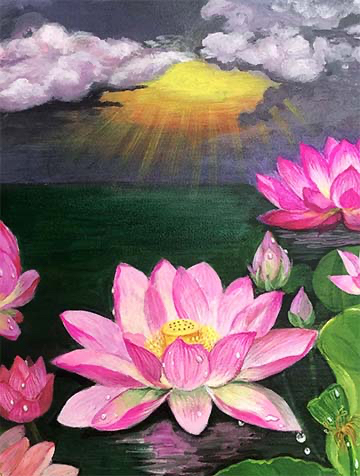(Minghui.org) Shen Yun, the world’s premier classical Chinese dance and music company, premiered “A Showcase of Shen Yun Dance Techniques” at 8 p.m. Eastern Daylight Time on May 31. The program presents two long-lost classical Chinese dance techniques: “shen-dai-shou” (the body leads the arms) and “kua-dai-tui” (the hips lead the legs). The two techniques represent the highest realm in dance techniques in the world, and the showcase by Shen Yun artists marks a new era of the revival of traditional culture.
“Shen-Dai-Shou” and “Kua-Dai-Tui”
According to the Shen Yun website, “Preserving 5,000 years of Chinese culture, built on traditional aesthetics, classical Chinese dance was once passed down among the people, in imperial courts, and through ancient plays. Over thousands of years, it was constantly refined, eventually developing into the vast and distinctly Chinese dance form we know today.” More specifically, classical Chinese dance focuses on shen-yun (bearing), shen-fa (form), and techniques.
“Classical Chinese dance, martial arts, and operatic dance are the very essence of China’s cultural sphere. Over the years, they have influenced and learned from one another. They have different objectives, but their movements and postures (shen-fa) and feeling are similar. When it comes to shen-fa, the highest achievement is “shen-dai-shou” (the body leads the arms), which has been passed down for thousands of years, and yet no one today knows how to do it or truly understands how to apply it,” according to the Shen Yun Creations website.
“Shen-dai-shou is also a method that has been persistently sought after by all kinds of dance forms and physical performing arts. It is a dance technique that people have been searching for since ancient times, something people have talked about but no one can do—it is the highest realm of artistic expression through physical movement. The founder, Artistic and Creative Director of Shen Yun Performing Arts, Mr. D.F., is the one who imparted this method. Shen-fa, moreover, also has the even better method of “kua-dai-tui” (the hips lead the legs), which modern people have not even heard about—an entirely lost art form. Having benefited from Mr. D.F.’s personal instruction in this method, Shen Yun now presents it to the public,” the website says.
Inheritance and Loss of Cultural Essence
China has a 5,000-year history of civilization. Also known as a culture inspired by the divine, its inner meanings are broad and profound. From the evolution of Chinese history, we can see that the essence of Chinese culture was passed down primarily in two ways: through family traditions and from masters teaching their disciples.
Regarding family traditions, from ancient books and artworks, we know of the saying “passing to son, not daughter.” It means whatever is passed down from one generation to the next, be it secret books or rare skills, it is only passed down to sons, not daughters, let alone people outside the family. If a man did not have a son, his rare skills would be lost.
For example, Luo Cheng and Qin Qiong were two renowned generals under Emperor Taizong of the Tang Dynasty. They were cousins and good friends. They promised to teach each other their respective family’s exclusive inherited martial arts skills, namely, the spear of the Luo family and the jian (a prism-shaped weapon) of the Qin family. But each man left out the most advanced part when teaching the other his rare skills.
Many people interpreted what they did as a means of preventing the other man from becoming superior. In reality, it could have been that, when they learned their exclusive skills from their respective fathers, they were told to pass them down only to a male offspring in the immediate family, not a cousin, and they would not have violated such a tradition.
Regarding masters passing down skills to their disciples, we can look at the story of Zhang Liang. As a strategist, Zhang was one of the three heroes who helped to establish the Han Dynasty. His encounter with Huang Shigong is a classic Chinese anecdote. History books have little additional information on Huang, other than his ownership of the book Liu Tao (Six Secret Strategic Teachings, also known as Taigong Art of War), a treatise on civil and military strategy written by ancient sage Jiang Ziya. Huang had been looking for someone to pass this book to—in traditional Chinese culture, there was a saying that “it is the master who looks for a disciple with potential.” After several tests, he accepted Zhang as his disciple and taught him this rare book. Later on, Zhang helped Liu Bang to establish the Han Dynasty. This treatise has now been passed onto Japan and some European countries as a valuable heritage of mankind.
Had Huang failed to meet someone as good as Zhang, this rare treatise could have been lost to history.
These two examples help us to understand how the essence of Chinese culture was inherited and lost throughout history. There could be other, deeper reasons why things happened this way, but they are not within the scope of this article.
“A Showcase of Shen Yun Dance Techniques,” a rare art and spiritual feast, premiered online May 31 at 8 p.m. (EDT) (8 a.m. on June 1 Beijing Time). The websites are: https://www.shenyuncreations.com/ (English) and https://www.shenyuncreations.com/zh_tw/ (Chinese).
All articles, graphics, and content published on Minghui.org are copyrighted. Non-commercial reproduction is allowed but requires attribution with the article title and a link to the original article.








